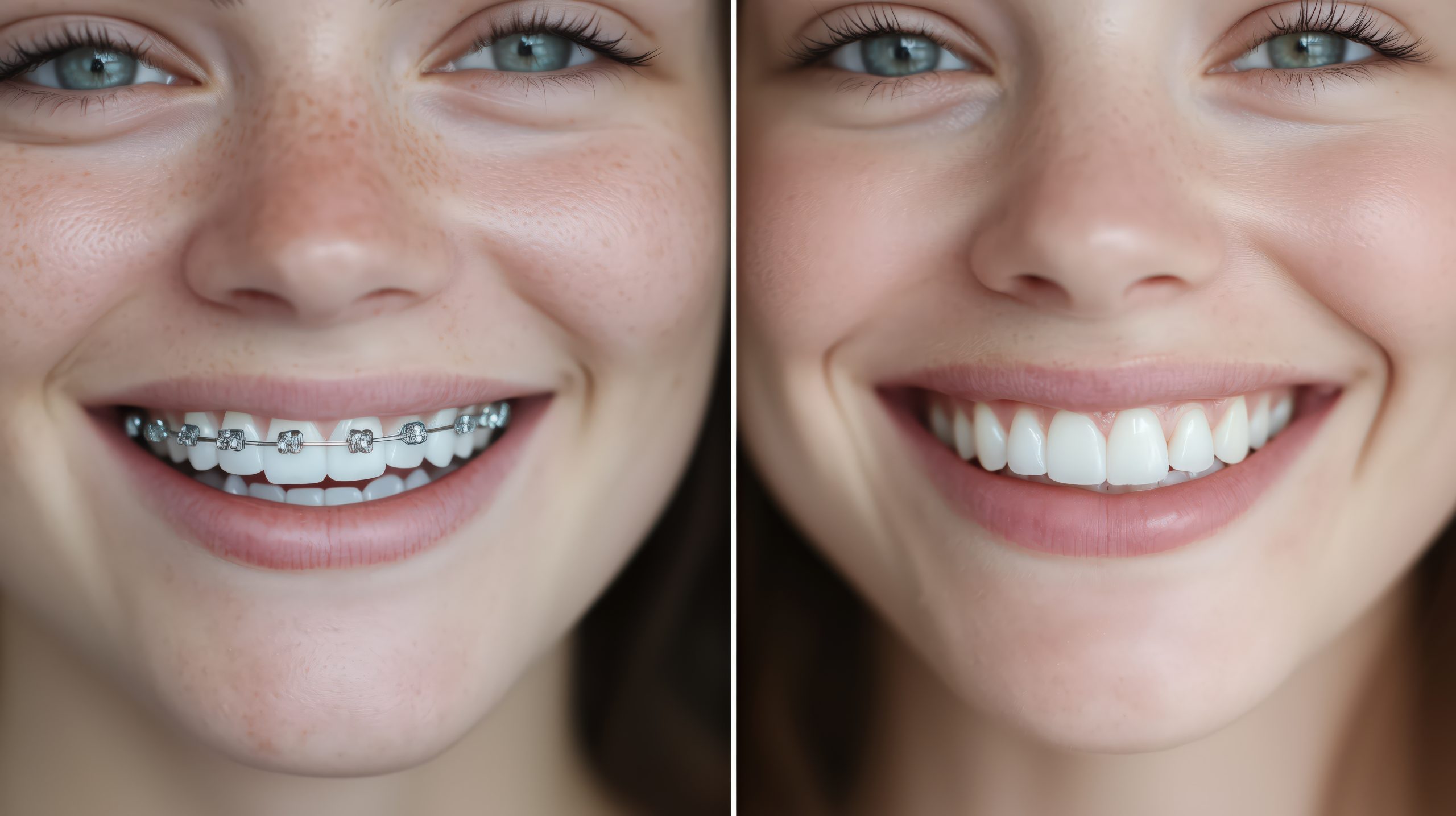Table of Contents
- So You Want to Improve Your Smile?
- What Are Traditional Braces?
- What Are Invisalign Clear Aligners?
- Invisalign vs Braces – Point-by-Point Comparison
- Appearance
- Discomfort and Pain
- Ease of Use
- Daily Care
- Effectiveness
- Follow Up Appointments
- Price of Treatment
- Extreme Activity/Contact Sports
- Length of Treatment
- Aftercare
- Conclusion
- What is This “Middle Ground”? – Ceramic Braces
So You Want to Improve Your Smile?
Invisalign or braces? It has always been a much-considered question for those wishing to improve their smile while achieving optimal oral health. Regular Invisalign maintenance is essential for effective treatment and maintaining oral health during the process.
The orthodontists in the PacificWest Dental team are experts in braces and Invisalign in Surrey and Vancouver areas. From the initial consultation, expert treatment plan, and through to your post-ortho care, our team with decades of experience will help you achieve your smile goals.
We offer every type of realignment method and are a Diamond Plus Invisalign Provider.
What Are Traditional Braces?
Traditional metal braces employ metal brackets attached to each tooth, which are then connected by a metal wire. Tiny elastics secure the bracket and wire together as teeth slowly realign.
Brackets can be metal, enamel-toned ceramic, or even coloured for the adventurous. It is also possible to mount them on the front or back face of the tooth.
Traditional braces are the most common orthodontic treatment that can correct everything from simplistic to the most complex cases.
What Are Invisalign Clear Aligners?
By nature, Invisalign was designed to be virtually invisible.
Using a series of BPA-free clear plastic trays on a prescribed timeline, they gently move your teeth and are removable for eating and drinking.
They are not suited for certain types of complex cases, however. But for typical smile realignment, they are as effective as traditional braces.
Invisalign vs Braces – Point-by-Point Comparison
What better way to discuss the differences between these treatment methods than putting them head to head?
Let’s take a look at which treatment option is preferable across various patient concerns and priorities.
Appearance
Invisalign:
- Invisalign is as described – practically invisible
- The smooth, clear plastic tray design makes them a very discreet option
- No discoloration of the aligner trays as they are removed for eating and drinking
- Require attachments (tiny tooth-coloured bumps) on the surface of the teeth that provide more surface area for the aligners to grab onto. These attachments are visible through the clear plastic
Braces:
- Metal braces are very noticeable
- Ceramic braces are harder to spot to the casual observer and can be an Invisalign alternative. However, it is still more obvious than Invisalign
Which is Better:
Invisalign in most cases
Hands down the winner every time if your priority is virtually undetectable smile realignment.
Ceramic braces in Surrey may be an alternative.
Discomfort and Pain
Invisalign:
- Often the more comfortable option with less pressure on the teeth overall and less soreness
- No sharp edges or wires that can cut inside the mouth or tongue
- However, it is more likely to create a lisp for the patient as the plastic tray covers the inside surface of the teeth. The lisp usually goes away within a week of full-time wear.
Braces:
- Traditional braces can cause more discomfort initially, but patients usually get used to them after 1-2 weeks
- Brackets and wires can have sharp edges that can cut inside the mouth, tongue, and inner lip
- A special mouth guard is recommended when playing contact sports to prevent cuts and injuries to the lip and cheeks from the braces.
- Those prone to canker sores may find themselves in greater discomfort
Which is Better:
Invisalign because of no poking wires and scratching gums.
Straightening teeth and the realignment process will always have some degree of discomfort regardless of the treatment option you choose.
But for those with a lower tolerance for pain, who are very active and into sports, or who do a physically strenuous job, Invisalign will be the best option.
Ease of Use
Invisalign:
- The real pro here is that you can still eat hard or sticky foods without worrying about breaking your appliances since the trays are removed for eating
- The con is that you might lose your tray/misplace it/forget to put it back in after eating, and they are only effective if worn for the prescribed minimum of 20-22 hours per day
Braces:
- The pro of braces is that they can’t come out of your mouth, so they are working for you 24/7
- The con is that you must avoid hard foods that you have to bite into (apples, steak, etc.) and also sticky or chewy foods which can stick to brackets as both types can break them — requiring extra trips to the orthodontist
- Metal braces can also be harder to keep clean, and food can often get stuck, making it awkward in social settings
Which One is Better?
Tie. Both methods have strengths and weaknesses.
If you are diligent about keeping them safe when removed and remember to wear them after eating (and also cleaning your teeth afterward) Invisalign in Surrey is ideal and highly convenient.
However, younger patients can often be better suited to braces to avoid the worry of losing aligners and ensuring the required wear time is not being compromised with the removable option.
Any convenience is a moot point when the treatment is compromised!
Daily Care
Invisalign:
- No real changes to dental hygiene are required; just brush and floss as normal
- The aligner trays must also be kept clean so require a rinse and light brushing each time you eat before placing them back into the mouth
- Deep cleans of the aligners to reach the crevices are also needed to prevent bacteria buildup, so you should follow your orthodontist’s recommendations
Braces:
- You can brush like normal with your manual or electronic toothbrush, but you do need to spend more time brushing as there is a lot more surface area to cover.
- Flossing requires special floss or floss threaders so it can go under the wire, which can be more time-consuming. But flossing is still essential for your oral hygiene
- Areas can be hard to reach, especially in the back teeth
- Extra care should be taken to ensure food isn’t stuck in the brackets, so a special smaller brush for braces may be useful
Which One is Better?
Invisalign – being able to take it out for cleaning makes things much easier.
Regular, thorough brushing and flossing is a must at all times, but even more so when undergoing orthodontic treatment. The introduction of foreign items into the mouth can provide a harbor for harmful bacteria, so extra care must be taken to keep all of the components clean, just like our teeth.
Invisalign in Vancouver makes that easier overall so wins this category.
Effectiveness
Invisalign:
- Extremely effective solution for most typical or simple cases
- The first con is when patients don’t comply with the required wear time of 20-22 hours per day which compromises the effectiveness
- Whenever the aligner comes out of the mouth, the teeth will start to go back to their original position. So if you lose your aligner or forget to wear it, your teeth are shifting back which slows down your progress
- At worst, if you are not able to consistently wear the aligner, your treatment may even be derailed and you will need to start over again
- Certain types of movements are more challenging for Invisalign to achieve, and the orthodontist may need to use adjunct appliances such as partial braces or elastic to help achieve those movements.
- Requires patients with discipline
Braces:
- The tried and tested method that sticks to a general timeline since they can’t be taken out and ‘underworn’ by the patient
- Effective for every type of movement and severe cases that Invisalign cannot treat
- Suitable for virtually all cases
Which One is Better?
Tie*. Dr. Wang and Dr. Lee are highly confident that both Invisalign and braces are effective at treating patients in most scenarios.
Invisalign and braces in Vancouver are both equally effective treatment options for the average patient looking for smile realignment. The onus is on the wearer to follow the orthodontist’s directions when choosing Invisalign to make this accurate, so diligence is required.
For specific situations where Invisalign is not able to deliver the desired outcome, we can use partial braces in conjunction with Invisalign (a hybrid), to achieve the optimal result.
Follow Up Appointments
Invisalign:
- Aligners are pre-made for a pre-determined schedule, so usually only require 1 to 2 major checkups with shorter visits every 8-12 weeks to ensure things are on track
- If things are going smoothly, fewer visits may be required
- Thanks to the development of virtual care through video conferencing, it is possible for the orthodontist to give all the trays to the patient and monitor remotely as the patient progresses through the treatment.
- Retainers need to be worn at night to maintain results once treatment has finished its course
Braces:
- Adjustments to the wire are required every 4-8 weeks to make sure teeth are moving toward the desired position as prescribed by the orthodontist.
- After treatment has reached completion, a retainer must be worn at night to prevent teeth from shifting back until the bone has stabilized
Which One is Better?
Invisalign for non-complex cases.
More flexibility and less frequent trips to the orthodontist make Invisalign a more convenient and attractive option. For more complex cases, the orthodontist would need to see you at more frequent intervals to make adjustments to the appliance, whether it is braces or Invisalign.
Price of Treatment
Invisalign:
- This can vary depending on how many trays are required to correct and realign your smile
- The degree of movement needed will impact the overall cost as a result
- Expect to pay anywhere between $7,500 – $10,000 for comprehensive treatment using Invisalign.
Braces:
- Traditional braces are generally more affordable with a lower starting price point
- The starting price for a comprehensive case with braces is around $6500. Complex cases still cost much more depending on the amount of manipulation and movement required to correctly realign your smile.
Which One is Better?
Braces – a clear winner in price.
Braces treatment costs can be more than 10% less than Invisalign. However, pricing is different for every orthodontic situation. It is a discussion to have with your orthodontist if pricing is a concern or a priority for your decision-making.
Extreme Activity/Contact Sports
Invisalign:
- With no metal components in the mouth with sharp edges or corners, the risk of soft tissue mouth trauma with accidental impact due to your treatment is virtually nil with aligners
- They can be worn as a type of mouthguard when playing most sports. For those sports involving extreme contact (ie, boxing, rugby), we recommend wearing the regular sports mouth guard in addition to your aligners.
Braces:
- Sharp corners and metal components are indeed a safety issue if there is any incidence of oral injury with traditional braces
- Brackets and wires may also be damaged requiring repairs at the orthodontist
- Severe injury and soft tissue tearing or abrasions on the inner lip are likely if there was any sudden impact
- Healing time could be compounded by wounds in contact with the metal components that remain in place
- An orthodontic mouthguard is the best option to protect your mouth from braces and accidental impacts
Which One is Better?
Invisalign. But still, be careful out there!
If the patient is very active in contact sports, aligners are the safest option and do not need to be removed while participating.
Length of Treatment
Invisalign:
- Depending on how diligent the patient is, minor corrective cases can be achieved in as little as six months
- More complex issues with realignment and bite can take up to 18 months again with diligent wear
Braces:
- Since braces tend to be chosen for treatments requiring a larger shift in repositioning dentition, there may be a false impression that they take longer
- Most cases are a year to 18 months, but as braces are also used exclusively for more complex cases, the time frame can be much longer for certain patients
Which One is Better?
Depends.
Only your orthodontist will be best positioned to discuss the timeframes you could expect with each of these treatment options. For mild cases, Invisalign in Surrey might be the winner, but again this is also keeping in mind that the patient adheres to the prescribed regimen.
Aftercare
Both Braces and Invisalign in Surrey will require that you wear a retainer at night to retain your results until the jaw bone has stabilized.
Failure to wear the retainer nightly will result in your teeth shifting back, which is not a risk worth taking after the time, effort, and cost that went into getting your perfect smile in the first place!
So there is no winner here, and we declare an emphatic TIE.
In Summary
| Braces (irremovable) | vs | Invisalign (removable) |
|---|---|---|
| Very noticeable, made of metal | Appearance | Virtually undetectable, clear smooth plastic |
| Discomfort & Pain |
|
PROS
| Ease of Use | PROS
|
| Brush as normal and use special floss to get under the wires or interdental floss sticks | Daily Care | Brush and floss as normal, clean trays using water, brush, and Invisalign Cleaner |
| Effective for simple to complex cases and everything in between | Effectiveness | Effective for mild to simple/average cases, but requires patient compliance |
| Require adjustments every 4-8 weeks and sometimes more often as required | Follow Up Appointments | Require follow-up visits every 8-12 weeks to monitor. Monitor appointments can be done virtually |
| $6,500 – $9,000 | Price of Comprehensive Treatment* | $7,500 – $10,000 |
| Can cause significant soft oral tissue injury, so an orthodontic mouthguard is a must | Extreme Activity/Contact Sports | No risks, the aligner does not need removal |
| Usually 18-24 months but varies by case | Length of Treatment | Anywhere from 6 – 18 months |
| Retainer at night | Aftercare | Retainer at night |
Determined on a case-by-case basis based on the patient’s situation. Please consult us for details.
Conclusion
As we can see above, there is a case for both types of orthodontic treatment.
The clear winner would appear to be Invisalign, but pricing may be out of reach for some. For younger patients, forgetful patients, and those who are unlikely to put in the hours needed for the aligners to do their job, braces may be the only practical option.
Braces are a surefire way to achieve your dream smile with decades of documented success for any correction required. However, they come with potentially a little more discomfort and some hassle with food choices and maintaining adequate oral hygiene.
Whichever treatment option you choose, we hope this was the definitive guide to helping you make the right choice if both are available to you.
What is This “Middle Ground”? – Ceramic Braces
We mentioned ceramic braces in our Invisalign versus Braces head-to-head comparison earlier.
Here is the low-down on why they are a sort of in-between category on their own:
- They are enamel toned to match your tooth colour. So your braces look less obvious even though they still use a bracket attached to the tooth and wires like regular metal braces
- Elastics can stain but are easily changed
- Brackets can stain but avoiding foods that typically discolour teeth helps along with fastidious cleaning
- Get the benefits of metal braces without them being noticeable unless they close up
- No risk of lengthening treatment due to not wearing them as they are irremovable
- Usually about $500 more expensive than their metal counterparts
So there you have it, there is a pricier middle ground out there if you can’t make up your mind between Invisalign and Braces in Surrey.
PacificWest Dental has two convenient locations in Vancouver and Surrey, B.C. Get in touch with us today to book your consultation and let us help you achieve your perfect smile.

Hello! I’m Dr. Kevin Lee, a certified orthodontic specialist at PacificWest Dental Group, proudly serving the vibrant communities of Vancouver and Surrey. My journey into orthodontics began back in high school. As a teenager wearing braces, I became fascinated by the intricate blend of art, engineering, and biology that defines this field. This early experience ignited a passion that has guided me throughout my career.
I pursued my academic journey at the University of British Columbia (UBC), where I earned a Bachelor of Science in Biochemistry in 2006, followed by a Doctor of Dental Medicine in 2011. After a year-long residency at Montefiore Medical Center in New York, I returned to UBC to complete a combined Master of Science in Craniofacial Biology and a Diploma in Orthodontics in 2015. That same year, I achieved certification from both the Royal College of Dentists of Canada and the American Board of Orthodontics.
With over a decade of clinical experience, I remain deeply committed to staying at the forefront of orthodontic advancements. At PacificWest Dental Group, we prioritize personalized treatment plans tailored to each patient’s unique needs, ensuring comfort and care every step of the way. Our goal is to help you achieve the smile you’ve always dreamed of in a welcoming and supportive environment.
Outside the clinic, I enjoy engaging with our community and staying active. Whether it’s through local events or outdoor activities, I believe in building strong relationships both inside and outside the office. I look forward to meeting you and working together to create a beautiful, confident smile.
Services we provide:
-Invisalign
-Braces
-Lingual Braces
-Digital treatment planning
-TMJ and headpain treatment
-Laser Therapy
-Sleep Apnea Oral Appliance
-Dysport Cosmetic Injectables





